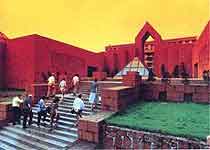
The Tomb Site of the Nanyue King
The tomb of the second Nanyue king was discovered by chance in June 1983 at a construction site in the Xianggang Hill in Guangzhou City. The State Council authorized the excavation of the tomb in October in the same year. 10,434 historical relics were unearthed including the Administrative Seal of Emperor Wen in gold. The seal proves the identity of the occupant of tomb to be the second king of the Nanyue Kingdom, Zhao Mo.
The Nanyue Kingdom was established more than two thousand years ago with its capital located in what is today the urban district of Guangzhou.
The tomb was located 20 meters into the center of the Xianggang Hill which was originally about 50 meters high. It was discovered intact and had not been plundered. The grave pit, with altogether seven chambers linked to one another, was divided into two parts. The part with rear rooms is located in the north, while the front in the south.
Fifteen sacrificial victims were found in the tomb. Those people were buried with the deceased emperor as part of the burial ritual. The tomb is the largest and the best protected found to date in the Lingnan region in south China. In 1996, the State Council declared it one of China's major historical sites.
The Location of the Tomb
In the ancient time, the emperors placed too much emphasis on the location of the tomb. On one hand, they wanted to choose a place with good "feng-shui" , and on the other hand to keep it away from tomb robbers.
The tomb of the second Nanyue king was buried 20 meters deep in the heart of the Xianggang Hill with its west to a lake. From the view of "feng-shui", it was really a very good location.
While it was built, the tomb was to the west of the city, and it was still the outskirts of the Guangzhou city in the Ming and Qing dynasties. However, with the growth of the city, it has been in the central area of the city.
